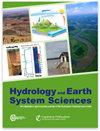Seasonal variation and influence factors of river water isotopes in the East Asian monsoon region: a case study in the Xiangjiang River basin spanning 13 hydrological years
IF 5.8
1区 地球科学
Q1 GEOSCIENCES, MULTIDISCIPLINARY
引用次数: 0
Abstract
Abstract. Seasonal variation and influencing factors of river water isotopes were investigated in the Xiangjiang River basin located in the East Asian monsoon region. This investigation involved comprehensive sampling of daily precipitation and river water with a 5 d interval as well as observing hydrometeorological factors spanning 13 hydrological years from January 2010 to December 2022, combined with the temporal and spatial correlation analyses based on linear regression and the isotopic Atmospheric Water Balance Model. Key findings are as follows: river water δ2H (δ2HR) exhibited significant seasonal variation, with the most positive and negative values occurring in the spring flood period and summer drought period, respectively, in alignment with those observed in precipitation. The correlations of the δ2HR with corresponding hydrometeorological factors with a 5 d interval were commonly weak due to the seasonality of precipitation isotopes and mixing of various water bodies within the basin, but the changes in the runoff (ΔR) and δ2HR (Δδ2HR) between two contiguous samplings with 5 d or higher intervals showed significant responses to the corresponding accumulated precipitation and evaporation. Prolonged rainless intervals with high evaporation rates in 2013 and 2022 as well as significant precipitation events in major flood periods in 2011 and 2017 had a significant impact on the δ2HR and runoff discharge. However, the most positive δ2HR values were primarily influenced by precipitation input with the most enriched isotopes in the spring flood period, while the moderately isotope-depleted precipitation during limited wetness conditions led to the most negative δ2HR. The spatial correlation analysis between water isotopes and hydrometeorological factors at the observing site and in the surrounding regions supported the representation of the Changsha site in the Xiangjiang River basin. These results underscore the potential of Δδ2HR as a proxy that reflects the seasonal variations in local environments, while caution is advised when interpreting extreme isotopic signals in river water. Overall, this study provides insights into the seasonal variation, extreme signal interpreting, and controlling factors of δ2HR in the study area, which was valuable for paleoclimate reconstruction and establishment of isotope hydrologic models.东亚季风区河水同位素的季节变化及影响因素——以湘江流域13年为例
摘要研究了东亚季风区湘江流域河水同位素的季节变化及其影响因素。通过对2010年1月至2022年12月13个水文年的日降水和河流水进行5 d间隔的综合采样,并结合基于线性回归和同位素大气水平衡模型的时空相关分析,对水文气象要素进行观测。结果表明:河流水δ2H (δ2HR)具有显著的季节变化特征,春涝期δ2H最大,夏旱期δ2HR最大,与降水δ2HR变化特征一致;由于降水同位素的季节性和流域内各种水体的混合,δ2HR与相应水文气象因子在5 d间隔内的相关性通常较弱,但连续两个采样间的径流(ΔR)和δ2HR (Δδ2HR)的变化对相应的累积降水和蒸发量有显著响应。2013年和2022年高蒸发率的较长无雨间断期以及2011年和2017年主要汛期的显著降水事件对δ2HR和径流流量有显著影响。然而,最大的正δ2HR值主要受春季汛期降水输入的影响,而有限湿润条件下的中度同位素耗尽降水导致最大的负δ2HR值。观测点及周边地区水同位素与水文气象因子的空间相关分析支持了长沙站点在湘江流域的代表性。这些结果强调了Δδ2HR作为反映当地环境季节性变化的代理的潜力,同时建议在解释河水中的极端同位素信号时要谨慎。总体而言,本研究揭示了研究区δ2HR的季节变化、极端信号解释和控制因素,对古气候重建和同位素水文模型的建立具有重要意义。
本文章由计算机程序翻译,如有差异,请以英文原文为准。
求助全文
约1分钟内获得全文
求助全文
来源期刊

Hydrology and Earth System Sciences
地学-地球科学综合
CiteScore
10.10
自引率
7.90%
发文量
273
审稿时长
15 months
期刊介绍:
Hydrology and Earth System Sciences (HESS) is a not-for-profit international two-stage open-access journal for the publication of original research in hydrology. HESS encourages and supports fundamental and applied research that advances the understanding of hydrological systems, their role in providing water for ecosystems and society, and the role of the water cycle in the functioning of the Earth system. A multi-disciplinary approach is encouraged that broadens the hydrological perspective and the advancement of hydrological science through integration with other cognate sciences and cross-fertilization across disciplinary boundaries.
 求助内容:
求助内容: 应助结果提醒方式:
应助结果提醒方式:


